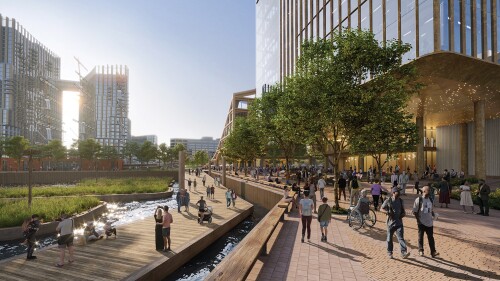How do you create built environments that actually improve health? Panelists at the ULI Fall Meeting said that successes in improving health need to be shared while meeting financial and investment objectives.
“Once you see these principles at work, it makes such an impact that there’s no going back,” said Susan Powers, president, Urban Ventures LLC. “I will never develop a project the way I did before Mariposa.”
Powers’s case study was Denver’s Mariposa affordable housing community, the redevelopment of a typical 1960s low-rise public housing property into a higher-density mixed-income, mixed-use neighborhood. Developed from a master plan by Mithun, Mariposa is enhancing walkability, adding community gardens, and improving access to health care and health information, among other strategies.
In a recent annual survey, residents reported that they had lost weight, decreased diabetes risk factors, increased physical activity, and expanded social engagement with their community.
While these self-reported findings fall short of quantitative research, the results are real and life-changing for the residents, and clearly a benefit of the redesign as observed by all of the team members, Powers observed.
Joanna Frank, executive director of the Center for Active Design, which is working with ULI’s Building Healthy Places Initiative, said, “Some changes are just a matter of thoughtful design, such as encouraging more walking... more people died worldwide last year from inactivity than from smoking.”
“When people can walk to places, bike easily, and enjoy outdoor or indoor activity, it’s the kind of place that’s going to be popular,” she said. “And that’s what developers want to create in the first place, and is one reason the shopping and office space can be financially successful.”
Another Denver site, ARIA, is a redesign of a former religious convent into a 450-unit housing community next to the Regis University campus.
“Our objectives at ARIA are to promote an active lifestyle, increase access to healthy food, and offer integrated health services,” said Powers. Among the strategies: Making biking not only easy but preferred, such as in giving every youngster a bike and encouraging biking to school, and creating a new exercise path that circled both ARIA and looped around the Regis University campus. The two-campus path not only allowed for a longer, more interesting exercise option but also increased engagement and community between the two communities, she said.
“The community garden has been very popular, too, providing healthy food for the table and getting kids to have fun picking vegetables while learning about nutrition,” she said.
The Mariposa and ARIA efforts were possible in part through grants from the Colorado Health Foundation.
Teng Chye Khoo, executive director, Centre for Liveable Cities, Singapore, shared progress being made in his island nation. The center collaborated with ULI last year and is doing another report this year on active mobility.
Khoo said Singapore’s growing interest in building healthy is because of its rapidly aging population and concern for health.
“Roads take up 12 percent of Singapore land, compared to 14 percent for housing, so we have a lot of roadway infrastructure, and a very deep connection to the auto,” he said. “We are working to discourage car use, and even charge a high fee for the right to own a car. Our objective is to help Singaporeans change their love affair with cars, and do more walking, biking, and taking transit.”
In addition to bringing in bike-share and improving bike access, Khoo said that Singapore is working to redesign properties to encourage walking. “A number of Singapore properties were built after the Modernist principals of towers with lots of green space in between, but people don’t walk across those distances in a hot and humid client like ours,” he said. “There’s a need to use more of the urban grid principles of activated walking areas with retail and things going on that attract you to go there.”
Jack Robbins, principal at FXFOWLE, cited a fact from the Centers for Disease Control and Prevention that obesity caused over 300,000 deaths last year.
“My question is, as developers and designers, can we change that by 50 , or 25 percent? Perhaps not, but even a change of 1 percent would save 3,000 lives. Our industry can do this,” he challenged.
At Le Central in New York’s Bronx area, Robbins’s team is working on an odd-shaped three-site property with a mix of housing—both high-rise and mid-rise—that will encourage walking and community engagement.
“One thing research shows is that painting shapes or objects onto blacktop in plazas or playgrounds gets kids engaged and active,” he said. “It doesn’t have to be shapes for specific game, just shapes. Kids’ creativity takes over from there.”





